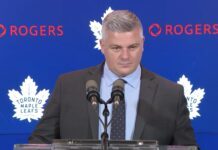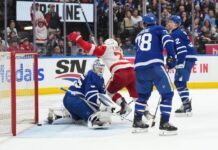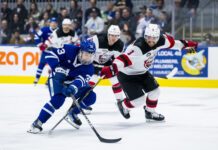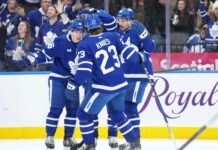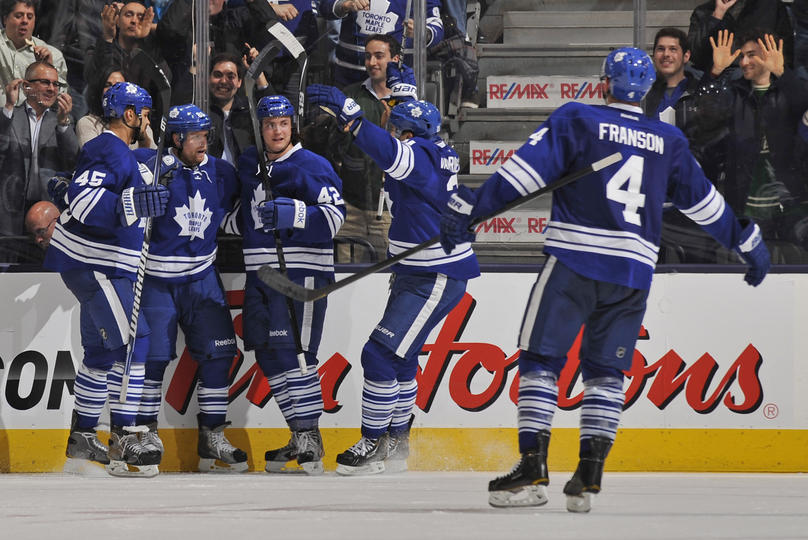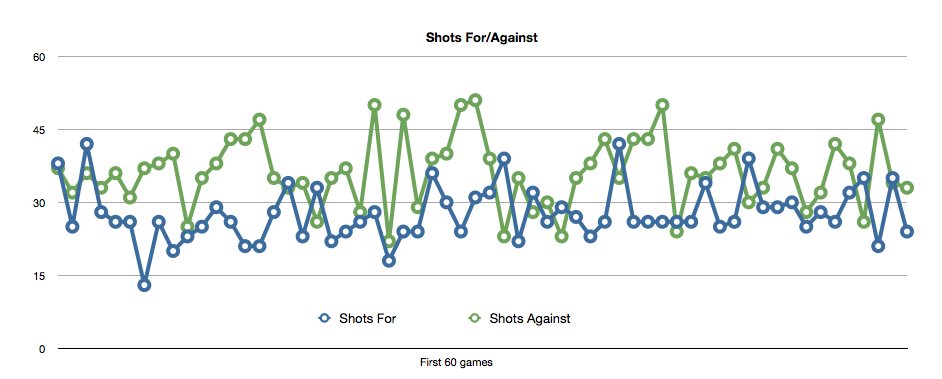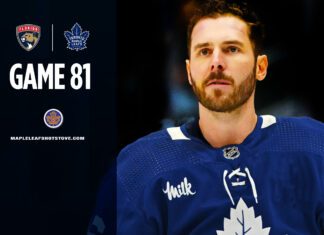Before the NHL broke for the Olympics, the Toronto Maple Leafs appeared to be playing some of their best hockey of the year at the right time of the season. We’ll have to see what happens if and when the top line cools off from the blazing pace it was enjoying when it left off, but the goal production has turned around in a big way in the past 13 games. Leaf sticks have been even hotter in the last 13 games than they were in the opening 14 games back in October.
While every 82-game season features ebbs and flows, the Leafs‘ up-and-down rollercoaster ride has been particularly pronounced. Whether a fan who just watches the games, an avid peruser of the numbers, or both, we can probably all agree the team has been an enigma wrapped in a puzzle.
The Leafs opened the month of the season scoring 3.4 goals a game while shooting a sky-high 12.8% on a very-low 26 shots per game. The top line, James van Riemsdyk and Phil Kessel more than Tyler Bozak, were lightning hot. Nazem Kadri, Mason Raymond, Dave Bolland and Joffrey Lupul were all chipping in regularly, filling out a formidable scoring cast. Jonathan Bernier and James Reimer came out of the gates tangled in a goaltending battle that brought out the best of both competitors throughout the first month of the season. The pair posted a combined .937 while facing 36 shots per game. Many fans and pundits took a step back, thumbed through some of the underlying numbers and wondered, “how long can this last?”
Well, November arrived and the Leafs hit a wall. The scoring dried up to the tune of just 2.18 goals per game during a 33-game stretch beginning on November 1st and ending in the middle of January. Bolland went down to a serious long-term injury in the first game of November, not to be heard from until March. Tyler Bozak, while plugging along at a .5 point-per-game pace before his first injury, was a significant loss to the infirmary as well. At one point, with Nazem Kadri suspended for three games, JvR was begrudgingly moved to center in what proved to be a failed experiment designed to fill the center-ice void. In early November the Leafs signed center Jerred Smithson, who quickly made it obvious he wasn’t of NHL-calibre while playing the next 17 games. Throughout much of the 30-some games, fourth line center and PK specialist Jay McClement regularly played 15-20 minutes as Randy Carlyle attempted to cope with the loss of trusted centers Dave Bolland and Tyler Bozak.
| Game Set | Record | G/G | S/G | SH% | GA/G | SA/G | SV% |
|---|---|---|---|---|---|---|---|
| First 14 | 10-4-0 | 3.4 | 26.2 | 12.8 | 2.3 | 36 | 0.937 |
| Middle 33 | 12-16-5 | 2.18 | 27.7 | 8 | 3.2 | 36.4 | 0.912 |
| Last 13 | 10-2-1 | 3.8 | 29 | 12.9 | 3.0 | 35.5 | 0.916 |
It was apparent then, and even more so now, that the three things that saved the Leafs from total disaster during that 33 game slump, what kept the Leafs in the playoff picture for all but one or two days, was their goalies’ ability to hold them in games, despite a tonne of shots against and little goal support, their powerplay, and their ability to win so many shootouts. A remarkable seven of the Leafs’ 12 wins came in shootout during this 33-game stretch, as the Leafs hung on by the skin of their teeth for two and a half months, equal parts plucky and lucky to collect 29 out of a possible 66 points despite an evaporation of even-strength offense, no reduction in shots against, a failing penalty kill, and a rise in goals against.
Special Teams
| First 14 | Middle 33 | Last 13 | |
|---|---|---|---|
| Goals For | 47 | 73 | 49 |
| PP Goals | 12 | 18 | 10 |
| PPG/G | 0.86 | 0.55 | 0.77 |
| % of Total GF | 25.5 | 24.7 | 20.4 |
| PP % | 25.5 | 22 | 24 |
| 5v5 Goals | 35 | 55 | 39 |
| 5v5 G/G | 2.5 | 1.7 | 3 |
| Goals Against | 32 | 106 | 39 |
| PK GA | 7 | 30 | 7 |
| PK GA/G | 0.5 | 0.91 | 0.54 |
| % of Total GA | 21.9 | 28% | 18% |
| PK % | 86.8 | 73 | 80.5 |
A particularly damaging part of the hockey club during its rough 33-game stretch was its penalty kill, something Gus Katsaros plans to explore in depth at the systems level in the next few weeks. It’s a small sample, but the Leafs have killed fourteen of their last fifteen over the past seven games (93.3%) while putting their units to work much less (fewer penalties). 14 kills are hardly a definitive indication that the troubles are behind them, but it’s something to build on, and is an area where the Leafs could reasonably stand to reduce their still-far-too-high goals against (25th in the NHL) despite great goaltending at five on five.
As mentioned, while the Leafs drew less powerplays during their downturn, their powerplay has been good all season and held up its end of the bargain when called upon. It’s been the resurgence in even strength offence that has keyed the 10-2-1 turnaround in the past 13.
Which brings us to…
The Big Line
| First 14 | Middle 33 | Last 13 | |||||||||||||
|---|---|---|---|---|---|---|---|---|---|---|---|---|---|---|---|
| GP | GOALS | ASSISTS | PTS | S/G | GP | GOALS | ASSISTS | PTS | S/G | GP | GOALS | ASSISTS | PTS | S/G | |
| Kessel | 14 | 8 | 10 | 18 | 6.3 | 33 | 12 | 12 | 24 | 4.0 | 13 | 10 | 13 | 23 | 3.4 |
| JVR | 12 | 7 | 5 | 12 | 3.4 | 33 | 10 | 11 | 21 | 3.6 | 13 | 7 | 6 | 13 | 3.5 |
| Bozak | 11 | 3 | 3 | 6 | 1.1 | 12 | 4 | 9 | 13 | 1.2 | 13 | 5 | 8 | 13 | 1.8 |
| Kadri | 14 | 5 | 8 | 13 | 1.7 | 29 | 6 | 7 | 13 | 1.9 | 13 | 4 | 11 | 15 | 1.8 |
| Lupul | 12 | 7 | 4 | 11 | 3.3 | 26 | 7 | 6 | 13 | 2.9 | 13 | 3 | 6 | 9 | 2.6 |
| Raymond | 14 | 5 | 6 | 11 | 2.6 | 33 | 7 | 10 | 17 | 1.8 | 13 | 4 | 3 | 7 | 2.5 |
Based on the degree to which the Leaf offense has lived and died by the top line, it’s safe to say the Leafs cannot afford a significant Olympic hangover on the part of Kessel and JvR, which Randy Carlyle has cautioned against having experienced it in Anaheim in 2010.
Interestingly, only for Bozak (who, even still, shoots very little) and Raymond has a rise in production come alongside an increase in shots. Phil was taking 6.3 shots per game during the hot start, 4.0 shots per game during the protracted slump, and has averaged just 3.4 during his recent, hottest streak of the season. Kessel’s shots are actually down, while JvR and Kadri have maintained a relatively constant rate in terms of their shots per game.
The big question facing the Leafs down the stretch is what happens when the top line cools off of their average of nearly four points per game over the past 13 games.
Reasons for Optimism
What the Leafs should be able to do this time around is avoid the collective, simultaneous slump from all of their key offensive players. Why did wingers JvR, Kessel, Lupul, Raymond all slow down at the same time during the Leafs’ protracted slump? Perhaps, to state the obvious, having quality centerman is important to overall team play, given both Bolland and Bozak were injured for much of the skid. It was also apparent that the Leafs’ only “established” centerman was a 23-year-old center, playing his first full 82-game season, who is still on a learning curve. Kadri experienced a rocky adjustment to tighter coverages playing in the stiffest matchups while centering the Leafs’ top line in Bozak’s absence.
Getting Bolland and Clarkson back together for the final stretch should be a positive development as far as the Leafs’ depth goes (scoring, on the cycle, their tough-to-play-against-ness). Another reason for optimism is that the lineup decisions are starting to make more sense:
- We’ve seen Carlyle find solutions at center rather than overplaying players of limited abilities, such as keeping Peter Holland in the team and trying out Nikolai Kulemin at center when Holland went down injured.
- A reported coaching adjustment encouraged more offensive involvement from the defence. Production from the defence and shots from the defence have risen accordingly. Rielly, Phaneuf, even Gunnarsson, have been more active in the Leaf attack. The Leafs have bumped their average shots up about by about a shot and a half per game in the past 13 games and brought their shots against down a shot per game on average. This doesn’t suggest a total reversal of the Leafs’ trademark trend, but it’s something.
- Tim Gleason has been a good addition, earning Carlyle’s trust and showing an ability to take on some defensive zone starts, as well as some general badassery when it comes to timely shot blocks and physical play.
It’s a Bizarre Team, guys
The Leafs finished sixth in offense while shooting 11.5% (2nd in the league) over all situations during the truncated season in 2012-13. With their recent hot stretch, the Leafs have moved themselves up to eighth in league scoring at 2.82 goals/game; meaning, between the Leafs’ “good” 27 games (October + the last 13 games) this season and 48 last, the Leafs have shot nearly 12% (all situations) and scored 3.3 goals per game over 75 games. They also spent a protracted spell playing like one of the worst teams in the League on both sides of the puck, with a 33-game run of shooting 8% and scoring 2.18 goals per game. They remain 25th in goals against despite some of the best goaltending in the League. The numbers below only further illuminate the confusing nature of this team:
Leafs Record While OutShot/OutShooting
| Season | Overall Record | Outshot | Outshooting |
|---|---|---|---|
| 2012-13 | 26 - 17 - 5 | 21 - 10 - 5 | 5 - 7 - 0 |
| 2013-14 | 32 - 22 - 6 | 25 - 17 - 6 | 7 - 4 - 0 |
| Total | 58 - 39 - 11 | 46 - 27 - 11 | 12 - 11 - 0 |
Overall, the Leafs have been outshot in 84 out of 108 games the past two seasons, including 49 out of 60 this season (see above). Now, no one is going to sit here and claim the criticisms of the club’s even strength possession play, and wavering 5v5 production, are unfounded; to put it simply, it’s the reason for the Leafs’ outrageous shot stats and it’s the thing holding the Leafs back from elevating from a pretty good team to a great one. But there is also something going on here beyond “great goaltending + luck.” There has to be an acknowledgement of the high skill level, of how the Leafs win games.
The Leafs do not set up the zone, cycle endlessly, and funnel shots at the net as a team like Los Angeles does. There is a tendency to hold onto the puck for an extra pass among the Leafs’ skilled group, a preference for high-skilled plays, an ability to score off quick strikes and odd man opportunities, and enough good shooters on the team to make it count. The downside is that their style of play leads to spells of dreadful hockey as the Leafs concede tidal waves of shots and own zone time. While their offensive weaponry has ensured a sustainably good powerplay, it has been a boom-or-bust offense at even strength.
The goaltending and the offensive production indicate the talent is here, but the defense still has a few players a notch or two above where they should be on the depth chart, which either has the Leafs playing a system that is trying to compensate for it or getting exposed by it (not sure which one, to be honest). The good news is that the potential on defense at the organizational level is strong and some of the future crop isn’t far away from budding, while the growth of a potentially elite talent is underway right under our noses with Morgan Rielly.
While definitely a talented group capable of producing, whether the Leafs have the right ‘mix’ of forwards also remains to be seen. The great part about Dave Bolland and David Clarkson getting back in time for this stretch run, along with Gleason in the role of “a far more capable version of Ryan O’Byrne/Mark Fraser,” is that we’ll find out what the team Dave Nonis and Randy Carlyle drew up in the summer looks like in action. A combined 90 missed games from off season signings/acquisitions in Bolland, Bozak and Clarkson, who have played a total of one game together, certainly wasn’t how Leafs brass drew it up back in July.
For all the Leafs’ flaws, they’re in a flawed Conference without any sort of discernible pecking order beyond the top two teams, one of which the Leafs seem to have no problem scoring against (Pittsburgh) and the other whom they had dead to rights in the playoffs last May (Boston). With their talent level and recent signs of improvement, there’s theoretically nothing stopping them from being the team who gets hot at the right time and wages damage in the East.
A Look Ahead
The Leafs, with a 32-22-6 record, have 70 points through 60 games played with 22 games remaining. Here’s a breakdown of those games.
Leafs' Remaining Opponents
| Remaining Opponents | W | L | OT/SOL | Season Series |
|---|---|---|---|---|
| NYI | 22 | 30 | 8 | 1-1 |
| Montreal | 32 | 21 | 6 | 2-1 |
| Columbus | 29 | 24 | 5 | 0-2 |
| NYR | 32 | 24 | 3 | 0-1-1 |
| Philadelphia | 30 | 23 | 6 | 1-0 |
| Anaheim | 41 | 14 | 5 | 1-0 |
| San Jose | 37 | 16 | 6 | 0-1 |
| Los Angeles | 31 | 22 | 6 | 0-1 |
| Washington | 27 | 23 | 9 | 1-1 |
| Detroit | 26 | 20 | 12 | 1-0-1 |
| Tampa Bay | 33 | 20 | 5 | 2-0 |
| Montreal | 32 | 21 | 6 | 2-1 |
| New Jersey | 24 | 22 | 13 | 2-0 |
| St. Louis | 39 | 12 | 6 | 0-1 |
| Philadelphia | 30 | 23 | 6 | 1-0 |
| Detroit | 26 | 20 | 12 | 1-0-1 |
| Calgary | 22 | 29 | 7 | 1-0 |
| Boston | 37 | 16 | 4 | 1-2 |
| Winnipeg | 28 | 26 | 6 | 0-0-1 |
| Tampa Bay | 33 | 20 | 5 | 2-0 |
| Florida | 22 | 29 | 7 | 1-2 |
| Ottawa | 26 | 22 | 11 | 3-0 |
| Total | 659 | 477 | 154 | 23 - 12 - 4 |
The Leafs have a tough schedule relative to their closest competitors in the East. Their opponents’ win percentage is third highest among the nine teams closest to them in the Eastern Conference standings. Those games against San Jose, Anaheim, Boston, Los Angeles and St. Louis certainly don’t sound welcoming, but it’s worth noting their excellent record against the remaining opponents overall based on the respective season series to date.
Strength of Schedule - Remaining Games
| Team | GR | Pts | Opponent Win% | Strength of Schedule |
|---|---|---|---|---|
| Washington | 23 | 63 | 0.547 | 1 |
| Detroit | 24 | 64 | 0.515 | 2 |
| Toronto | 22 | 70 | 0.511 | 3 |
| Montreal | 23 | 70 | 0.509 | 4 |
| Columbus | 24 | 63 | 0.495 | 5 |
| Carolina | 25 | 61 | 0.482 | 6 |
| Ottawa | 23 | 63 | 0.478 | 7 |
| Tampa Bay | 24 | 71 | 0.474 | 8 |
| New Jersey | 23 | 61 | 0.468 | 9 |
The current projected playoff cut-off mark, based on the points pace of the final wildcard team, is 90.5 points. The Leafs, currently on a 96-point pace, will need 21 points out of their remaining 22 games. A 10-11-1 or 9-10-3 record is likely all the Leafs will need to ensure their second consecutive playoff appearance in April.
A furious race to the finish line starts February 27 against the New York Islanders.





